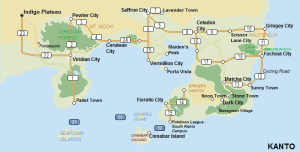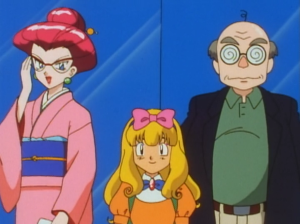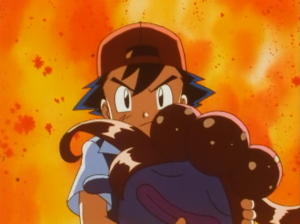New thing, just fyi–I’m going to start putting the main conclusions in bold at the end of each long-form post as a sort of TL;DR.
I’ve talked before about the faux-wilderness space of Kanto. The hardship of a badge-collecting journey is a form of education–remember how the private school, Pokémon Tech, is an accepted substitute for the badges? It may also be a test of a trainer’s worthiness. That said, Kanto’s rugged land is engineered to be challenging but accessible, a rigorous way of learning to be a trainer that’s open to all.

Hop Hop Hop Town, an interpretive dance
What about the cities, though? There are some interesting visuals of Ash, Brock, Misty, and Pikachu in urban space that frame Kanto’s cities as more confusing than the rugged space in between them.
To get us oriented and showcase some cool maps I found, here’s Kanto with all the locations in the anime (and from the games, I think) marked.1

A little clearer but slightly less gorgeous is this roadmap created by a user of Serebii.net.

source found here
There’s a lot of space between and around the cities. This makes sense–the faux-wilderness serves as a standing reserve for wild ‘mon, like pastureland for lightly-tended livestock.
Ash and co are always overjoyed when they reach a city, often because they’ve been wandering lost for weeks. “Lost,” though, not in the sense that they were wandering the woods fearing for their lives, but rather in the sense of being unsure of exactly what footpaths they were on. Although when they reach Vermilion they haven’t “had anything decent to eat for three days,” they still seem to have had something. Vermilion offers them a wash, some food, and a place to sleep that isn’t the ground, but they don’t seem to have been in real danger.
Reaching “civilization,” though, doesn’t solve their problem of being lost. In fact, visually, the urban spaces are far more dizzying and overwhelming than their time wandering. First, here’s a visual comparison of two scenes in which the characters are “lost.”
wandering. First, here’s a visual comparison of two scenes in which the characters are “lost.”
The images show Ash, Misty, and Brock in Hop Hop Hop Town (a suburb of Celadon) and on their journey en route to Vermilion. Notice how they look at least as confused in Hop Hop Hop as they did in the forest. In both images Brock is studying the map, the others looking vaguely confused.
The perspective is different, too. While the characters seem small from an overhead view, it also gives a sense of depth to the forest and a sense of space. In the city, note the frequent use of low perspective and the claustrophobic feel of the background to create a sense of the looming surroundings. The scenery of the urban spaces is far more overwhelming and, paradoxically, limited than any forest we’ve seen.  In fact, the first dialogue in ep. 1.27 (spoken along with the top image in the collection at the left) is about how lost they feel, even though they’ve just left Celadon and are obviously on a main road.
In fact, the first dialogue in ep. 1.27 (spoken along with the top image in the collection at the left) is about how lost they feel, even though they’ve just left Celadon and are obviously on a main road.
Ash: I feel like the buildings are closing in on us.
Misty: Yeah, and they’re all so tall you can hardly see any sky.
Usually, in our world, when urban space is described as claustrophobic, it’s also easily navigable. You feel trapped and isolated, but usually you know how to get around, with street signs and subways and taxis. The wilderness, in contrast, is huge and free from social constraints and refreshing, but also, in this binary, prone to swallowing you up in its un-navigable vastness. This isn’t how it goes in Kanto, though.
Something else troubles this familiar contrast of city and nature, because in Kanto the rural space is where Ash acquires the non-human bodies he uses to win badges. The wilderness is a place of acquisition, which is the opposite of how we in our world conceive of wilderness vs. urban space. Usually when contrasted with human space/society/cities, our world’s idea of wilderness is of freedom from The System, from consumerism and human desires, a return to simpler living. (This is, of course, a social fiction, as in our own world everything is a commodity, but I digress…)
The city is still a place of advertisement and consumerism in Kanto, but look at these pictures of advertisements from ep. 1.28, “Pokemon Fashion Flash.”  Note all of the pokémon images used. We’ve seen similar advertising and pokémon-branded products before, including Cerulean coffee and Mt. Moon spring water. It all refers back to pokémon bodies, explicitly, and those bodies are acquired outside the city.
Note all of the pokémon images used. We’ve seen similar advertising and pokémon-branded products before, including Cerulean coffee and Mt. Moon spring water. It all refers back to pokémon bodies, explicitly, and those bodies are acquired outside the city.
The fact that urban advertisements so clearly, consistently refer to pokémon bodies, and the fact that Ash often feels pressure to continue his travels in order to catch more pokémon (and feels like a failure when he’s told how few he’s acquired in comparison to Gary), indicates that in Kanto, nature is a place where consumerism happens. In Kanto, “Nature” is not a place to escape capitalism but where you go to get the materials (bodies) you need to participate in the competitive system. Bodies and nature are explicitly thought of as capital. We see this in the way Ash evaluates each new location based on what bodies if offers him.2 The cities, in contrast, are places where the characters go to refresh themselves for a short time before returning to the hard work of their training journey. The cities offer food and rest but are confusing, more human but no more navigable than the accessible wilderness where Ash and co. spend most of their time.
Bonus: real-world application
So this time I actually think this reflects in a significant way on our own world’s ideas of human and non-human space. I mentioned before how everything is commodified, and you only have to look at the kerfuffle surrounding drought-stricken B.C.’s sale of water to Nestle to realize that oil, water, trees, everything is bought and sold all the time.
We still like to think of “Nature” as a place where we can get away from the ravages of capitalism and consumerist drive, though. It’s nice to imagine, fantasize that this is possible. We maintain this social fiction that there are non-human spaces, but we do so less and less as the century progresses. Just look at the rhetoric surrounding the recent creation of the world’s largest marine reserve back in September of 2014. The project’s motivation was presented, not as a desire to protect our nonhuman neighbors from our own avarice (which should be an end in itself) but, in the words of U.S. Secretary of State John Kerry, “a responsibility to make sure. . . the future has the same ocean to serve it. Not to be abused, but to preserve and utilize” (“Marine Reserve”). Protecting this area of the Pacific must be justified as protecting a commodity or a product.
I would suggest that as the permanence of the world as we know it becomes more uncertain, and the rarity and value of natural commodities rise accordingly, our culture is more explicitly beginning to talk about water, animal bodies, oil, etc. as things with an inherent value, a price tag. Nature, in our world’s increasingly neoliberal paradigm of thought, is becoming more explicitly, as in Kanto, a place made up not of significant non-human others, but of capital and commodity. Kanto’s somewhat flipped idea of urban and rural is our own world’s logical next step.
1. The map is official game artwork, and the locations are added by this forum user whose angsty profile indicates an early teen, but whose much-appreciated thoroughness and consistency of image edits suggests someone of greater years and wisdom, so Arceus bless you, mysterious stranger on a now-defunct forum.↩
2. In the image of the gang reading a map in the forest, Ash has binoculars. In this scene he uses the binoculars to scan a distant meadow for pokémon and is disappointed to see only spearow, which he seems to feel aren’t worth his time. He objectifies and evaluates all the bodies he encounters on his journey because nature is essentially a space of consumerism. This would align with the paradigm of ownership (i.e., how everyone talks about ‘mon as if they were owned or will someday be owned, seemingly lacking the concept of a happily un-owned pokémon). Each place is evaluated for what resources it offers, and how rare/strong those resources are. Basically, the wilderness is a large, exceptionally violent shopping mall.↩

 hoping to use Ash’s battle with Erica as a cover for their own thieving. Ash, after a brief side eye, goes along with their plan which, in a lovely little twist, is to dress Ash up like a very girly girl. When he declares he can now “show [Erica] who’s the boss around here,” Jesse warns him that “That doesn’t sound very lady-like!” That is, Ash must perform a stereotypical mode of femininity similar to the one he so vocally despised in the perfume shop. Will this lead to Ash learning to be more understanding?
hoping to use Ash’s battle with Erica as a cover for their own thieving. Ash, after a brief side eye, goes along with their plan which, in a lovely little twist, is to dress Ash up like a very girly girl. When he declares he can now “show [Erica] who’s the boss around here,” Jesse warns him that “That doesn’t sound very lady-like!” That is, Ash must perform a stereotypical mode of femininity similar to the one he so vocally despised in the perfume shop. Will this lead to Ash learning to be more understanding?
 with
with  Gloom isn’t stenching. Gloom must feel safe. So… has Ash demonstrated empathy through earning Gloom’s trust?
Gloom isn’t stenching. Gloom must feel safe. So… has Ash demonstrated empathy through earning Gloom’s trust?